Phytochemical Composition, Antioxidant Activity, α-Glucosidase and Acetylcholinesterase Inhibitory Activity of Quinoa Extract and Its Fractions
Abstract
:1. Introduction
2. Results and Discussion
2.1. Total Phenolics and Flavonoids Content
2.2. In Vitro Antioxidant Activities
2.2.1. DPPH Radical Scavenging Activity
2.2.2. ABTS Radical Scavenging Activity
2.2.3. Ferric Reducing Antioxidant Power
2.2.4. Oxygen Radical Absorbance Capacity
2.3. α-Glucosidase Inhibitory Activity
2.4. Acetylcholinesterase Inhibitory Activity
2.5. Ultra-Performance Liquid Chromatography-Mass Spectrometry Analysis
3. Materials and Methods
3.1. Materials and Reagents
3.2. Sample Preparation
3.3. Total Phenolics Content (TPC)
3.4. Total Flavonoids Content (TFC)
3.5. Antioxidant Activities
3.5.1. DPPH Radical Scavenging Activity
3.5.2. ABTS Radical Scavenging Activity
3.5.3. Ferric Reducing Antioxidant Power (FRAP)
3.5.4. Oxygen Radical Absorbance Capacity (ORAC)
3.6. Enzyme Inhibitory Ability
3.6.1. Inhibition activity of α-Glucosidase
3.6.2. Inhibition Activity of Acetylcholinesterase
3.7. UPLC-MS/MS Analysis
3.8. Statistical Analysis
4. Conclusions
Supplementary Materials
Author Contributions
Funding
Institutional Review Board Statement
Informed Consent Statement
Data Availability Statement
Acknowledgments
Conflicts of Interest
References
- Kozioł, M.J. Chemical composition and nutritional evaluation of quinoa (Chenopodium quinoa Willd.). J. Food Compos. Anal. 1992, 5, 35–68. [Google Scholar] [CrossRef]
- Choukr-Allah, R.; Rao, N.K.; Hirich, A.; Shahid, M.; Alshankiti, A.; Toderich, K.; Gill, S.; Butt, K.U.R. Quinoa for marginal environments: Toward future food and nutritional security in MENA and central Asia regions. Front. Plant Sci. 2016, 7, 346. [Google Scholar] [CrossRef] [PubMed] [Green Version]
- Pereira, E.; Encina-Zelada, C.; Barros, L.; Gonzales-Barron, U.; Cadavez, V.; Ferreira, I.C.F.R. Chemical and nutritional characterization of Chenopodium quinoa Willd (quinoa) grains: A good alternative to nutritious food. Food Chem. 2019, 280, 110–114. [Google Scholar] [CrossRef] [PubMed] [Green Version]
- Ruales, J.; Nair, B.M. Saponins, phytic acid, tannins and protease inhibitors in quinoa (Chenopodium quinoa, Willd) seeds. Food Chem. 1993, 48, 137–143. [Google Scholar] [CrossRef]
- Escribano, J.; Cabanes, J.; Jiménez-Atiénzar, M.; Ibañez-Tremolada, M.; Gómez-Pando, L.R.; García-Carmona, F.; Gandía-Herrero, F. Characterization of betalains, saponins and antioxidant power in differently colored quinoa (Chenopodium quinoa) varieties. Food Chem. 2017, 234, 285–294. [Google Scholar] [CrossRef]
- Tang, Y.; Li, X.H.; Chen, P.X.; Zhang, B.; Hernandez, M.; Zhang, H.; Marcone, M.F.; Liu, R.H.; Tsao, R. Characterisation of fatty acid, carotenoid, tocopherol/tocotrienol compositions and antioxidant activities in seeds of three Chenopodium quinoa Willd. genotypes. Food Chem. 2015, 174, 502–508. [Google Scholar] [CrossRef]
- Zeng, J.; Shang, X.; Zhang, P.; Wang, H.; Gu, Y.; Tan, J.N. Combined use of deep eutectic solvents, macroporous resins, and preparative liquid chromatography for the isolation and purification of flavonoids and 20-Hydroxyecdysone from Chenopodium quinoa Willd. Biomolecules 2019, 9, 776. [Google Scholar] [CrossRef] [Green Version]
- Hu, Y.C.; Zhang, J.M.; Zou, L.; Fu, C.M.; Li, P.; Zhao, G. Chemical characterization, antioxidant, immune-regulating and anticancer activities of a novel bioactive polysaccharide from Chenopodium quinoa seeds. Int. J. Biol. Macromol. 2017, 99, 622–629. [Google Scholar] [CrossRef]
- Aviello, G.; Knaus, U.G. NADPH oxidases and ROS signaling in the gastrointestinal tract. Mucosal Immunol. 2018, 11, 1011–1023. [Google Scholar] [CrossRef] [Green Version]
- Rosales-Corral, S.; Tan, D.-X.; Manchester, L.; Reiter, R.J. Diabetes and Alzheimer disease, two overlapping pathologies with the same background: Oxidative stress. Oxidative Med. Cell. Longev. 2015, 2015, 985845. [Google Scholar] [CrossRef]
- Han, Y.M.; Chi, J.W.; Zhang, M.W.; Zhang, R.F.; Fan, S.H.; Dong, L.H.; Huang, F.; Liu, L. Changes in saponins, phenolics and antioxidant activity of quinoa (Chenopodium quinoa willd) during milling process. LWT-Food Sci. Technol. 2019, 114, 108381. [Google Scholar] [CrossRef]
- Gawlik-Dziki, U.; Świeca, M.; Sułkowski, M.; Dziki, D.; Baraniak, B.; Czyż, J. Antioxidant and anticancer activities of Chenopodium quinoa leaves extracts—In vitro study. Food Chem. Toxicol. 2013, 57, 154–160. [Google Scholar] [CrossRef] [PubMed]
- Lim, J.G.; Park, H.M.; Yoon, K.S. Analysis of saponin composition and comparison of the antioxidant activity of various parts of the quinoa plant (Chenopodium quinoa Willd.). Food Sci. Nutr. 2020, 8, 694–702. [Google Scholar] [CrossRef] [PubMed] [Green Version]
- McGivern, B.B.; Tfaily, M.M.; Borton, M.A.; Kosina, S.M.; Daly, R.A.; Nicora, C.D.; Purvine, S.O.; Wong, A.R.; Lipton, M.S.; Hoyt, D.W.; et al. Decrypting bacterial polyphenol metabolism in an anoxic wetland soil. Nat. Commun. 2021, 12, 2466. [Google Scholar] [CrossRef]
- Abubakar, M.B.; Abdullah, W.Z.; Sulaiman, S.A.; Ang, B.S. Polyphenols as key players for the antileukaemic effects of propolis. Evid.-Based Complementary Altern. Med. 2014, 2014, 371730. [Google Scholar] [CrossRef] [Green Version]
- Li, R.; Ru, Y.; Wang, Z.; He, X.; Kong, K.-W.; Zheng, T.; Zhang, X. Phytochemical Composition, Antioxidant Activity, and Enzyme Inhibitory Activities (α-Glucosidase, Xanthine Oxidase, and Acetylcholinesterase) of Musella lasiocarpa. Molecules 2021, 26, 4472. [Google Scholar] [CrossRef]
- Gupta, A.K.; Rather, M.A.; Jha, A.K.; Shashank, A.; Mastinu, A. Artocarpus lakoocha roxb. and artocarpus heterophyllus Lam. flowers: New sources of bioactive compounds. Plants 2020, 9, 1329. [Google Scholar] [CrossRef]
- Kaviarasan, S.; Naik, G.H.; Gangabhagirathi, R.; Anuradha, C.V.; Priyadarsini, K.I. In vitro studies on antiradical and antioxidant activities of fenugreek (Trigonella foenum graecum) seeds. Food Chem. 2007, 103, 31–37. [Google Scholar] [CrossRef]
- Kaur, N.; Arora, D.S.; Kalia, N.; Kaur, M. Bioactive potential of endophytic fungus Chaetomium globosum and GC-MS analysis of its responsible components. Sci. Rep. 2020, 10, 18792. [Google Scholar] [CrossRef]
- Baek, S.-H.; Nam, I.-J.; Kwak, H.S.; Kim, K.-C.; Lee, S.-H. Cellular anti-melanogenic effects of a euryale ferox seed extract ethyl acetate fraction via the lysosomal degradation machinery. Int. J. Mol. Sci. 2015, 16, 9217–9235. [Google Scholar] [CrossRef] [Green Version]
- Mahendra Kumar, C.; Singh, S.A. Bioactive lignans from sesame (Sesamum indicum L.): Evaluation of their antioxidant and antibacterial effects for food applications. J. Food Sci. Technol. 2015, 52, 2934–2941. [Google Scholar] [CrossRef] [PubMed] [Green Version]
- Mahomoodally, M.F.; Subratty, A.H.; Gurib-Fakim, A.; Choudhary, M.I.; Khan, S.N. Traditional medicinal herbs and food plants have the potential to inhibit key carbohydrate hydrolyzing enzymes in vitro and reduce postprandial blood glucose peaks in vivo. Sci. World J. 2012, 2012, 285284. [Google Scholar] [CrossRef] [PubMed] [Green Version]
- Tang, Y.; Zhang, B.; Li, X.; Chen, P.X.; Zhang, H.; Liu, R.; Tsao, R. Bound phenolics of quinoa seeds released by acid, alkaline, and enzymatic treatments and their antioxidant and α-glucosidase and pancreatic lipase inhibitory effects. J. Agric. Food Chem. 2016, 64, 1712–1719. [Google Scholar] [CrossRef] [PubMed]
- Das, S.; Roy, P.; Pal, R.; Auddy, R.G.; Chakraborti, A.S.; Mukherjee, A. Engineered silybin nanoparticles educe efficient control in experimental diabetes. PLoS ONE 2014, 9, e101818. [Google Scholar] [CrossRef] [Green Version]
- Hardy, J.; Selkoe, D.J. The amyloid hypothesis of Alzheimer’s disease: Progress and problems on the road to therapeutics. Science 2002, 297, 353–356. [Google Scholar] [CrossRef] [Green Version]
- Simeonova, R.; Zheleva, D.; Valkova, I.; Stavrakov, G.; Philipova, I.; Atanasova, M.; Doytchinova, I. A novel galantamine-curcumin hybrid as a potentialmulti-target agent against neurodegenerative disorders. Molecules 2021, 26, 1865. [Google Scholar] [CrossRef]
- Blaženović, I.; Kind, T.; Ji, J.; Fiehn, O. Software tools and approaches for compound identification of LC-MS/MS data in metabolomics. Metabolites 2018, 8, 31. [Google Scholar] [CrossRef] [Green Version]
- Lin, M.; Han, P.; Li, Y.; Wang, W.; Lai, D.; Zhou, L. Quinoa secondary metabolites and their biological activities or functions. Molecules 2019, 24, 2512. [Google Scholar] [CrossRef] [Green Version]
- Yan, S.; Dong, X. Perception of the plant immune signal salicylic acid. Curr. Opin. Plant Biol. 2014, 20, 64–68. [Google Scholar] [CrossRef] [Green Version]
- Sankaranarayanan, R.; Valivetiet CKKumar, R.; Slambrouck, S.V.; Kesharwani, S.S.; Seefeldt, T.; Scaria, J.; Tummala, H.; Bhat, J. The flavonoid metabolite 2,4,6-trihydroxybenzoic acid is a CDK inhibitor and an anti-proliferative agent: A potential role in cancer prevention. Cancers 2019, 11, 427. [Google Scholar] [CrossRef] [Green Version]
- Michel, M.C.; Bohner, H.; Köster, J.; Schäfers, R.; Heemann, U. Safety of Telmisartan in Patients with arterial hypertension. Drug Saf. 2004, 27, 335–344. [Google Scholar] [CrossRef] [PubMed]
- Kennedy, D.G.; Blanchflower, W.J.; O’Dornan, B.C. Development of an ELISA for lasalocid and depletion kinetics of lasalocid residues in poultry. Food Addit. Contam. 1995, 12, 83–92. [Google Scholar] [CrossRef] [PubMed]
- Liu, M.; Zhu, K.; Yao, Y.; Chen, Y.; Li, J. Antioxidant, anti- inflammatory, and antitumor activities of phenolic compounds from white, red, and black Chenopodium quinoa seed. Cereal Chem. 2020, 97, 703–713. [Google Scholar] [CrossRef]
- Paśko, P.; Bartoń, H.; Zagrodzki, P.; Gorinstein, S.; Fołta, M.; Zachwieja, Z. Anthocyanins, total polyphenols and antioxidant activity in amaranth and quinoa seeds and sprouts during their growth. Food Chem. 2009, 115, 994–998. [Google Scholar] [CrossRef]
- Tang, Y.; Li, X.; Zhang, B.; Chen, P.X.; Liu, R.; Tsao, R. Characterisation of phenolics, betanins and antioxidant activities in seeds of three Chenopodium quinoa Willd. genotypes. Food Chem. 2015, 166, 380–388. [Google Scholar] [CrossRef]
- Tang, W.; Xing, Z.; Li, C.; Wang, J.; Wang, Y. Molecular mechanisms and in vitro antioxidant effects of Lactobacillus plantarum MA2. Food Chem. 2017, 221, 1642–1649. [Google Scholar] [CrossRef] [PubMed]
- Guedes, A.C.; Amaro, H.M.; Gião, M.S.; Malcata, F.S. Optimization of ABTS radical cation assay specifically for determination of antioxidant capacity of intracellular extracts of microalgae and cyanobacteria. Food Chem. 2013, 138, 638–643. [Google Scholar] [CrossRef] [PubMed]
- Hernández-Ledesma, B.; Amigo, L.; Recio, I.; Bartolomé, B. ACE-inhibitory and radical-scavenging activity of peptides derived from β-Lactoglobulin f (19−25). Interactions with ascorbic acid. J. Agric. Food Chem. 2007, 55, 3392–3397. [Google Scholar] [CrossRef]
- Liao, H.; Banbury, L.; Liang, H.; Wang, X.; Lü, X.; Hu, L.; Wu, J. Effect of Honghua (Flos Carthami)on nitric oxide production in RAW 264.7 cells and α-glucosidase activity. J. Tradit. Chin. Med. 2014, 34, 362–368. [Google Scholar] [CrossRef] [Green Version]
- Lee, J.-S.; Min, G.-H.; Lee, J.-S. Nutritional and Physicochemical Characteristics of the Antidementia Acetylcholinesterase-Inhibiting Methanol Extracts from Umbilicaria esculenta. Mycobiology 2009, 37, 203–206. [Google Scholar] [CrossRef] [Green Version]
- Xie, X.; Tu, Z.-C.; Zhang, L.; Zhao, Y.; Wang, H.; Wang, Z.-X.; Zhang, N.-H.; Zhong, B.-Z. Antioxidant activity, α-glucosidase inhibition, and phytochemical fingerprints of Anoectochilus roxburghiiformula tea residues with HPLC-QTOF-MS/MS. J. Food Biochem. 2017, 41, e12402. [Google Scholar] [CrossRef]
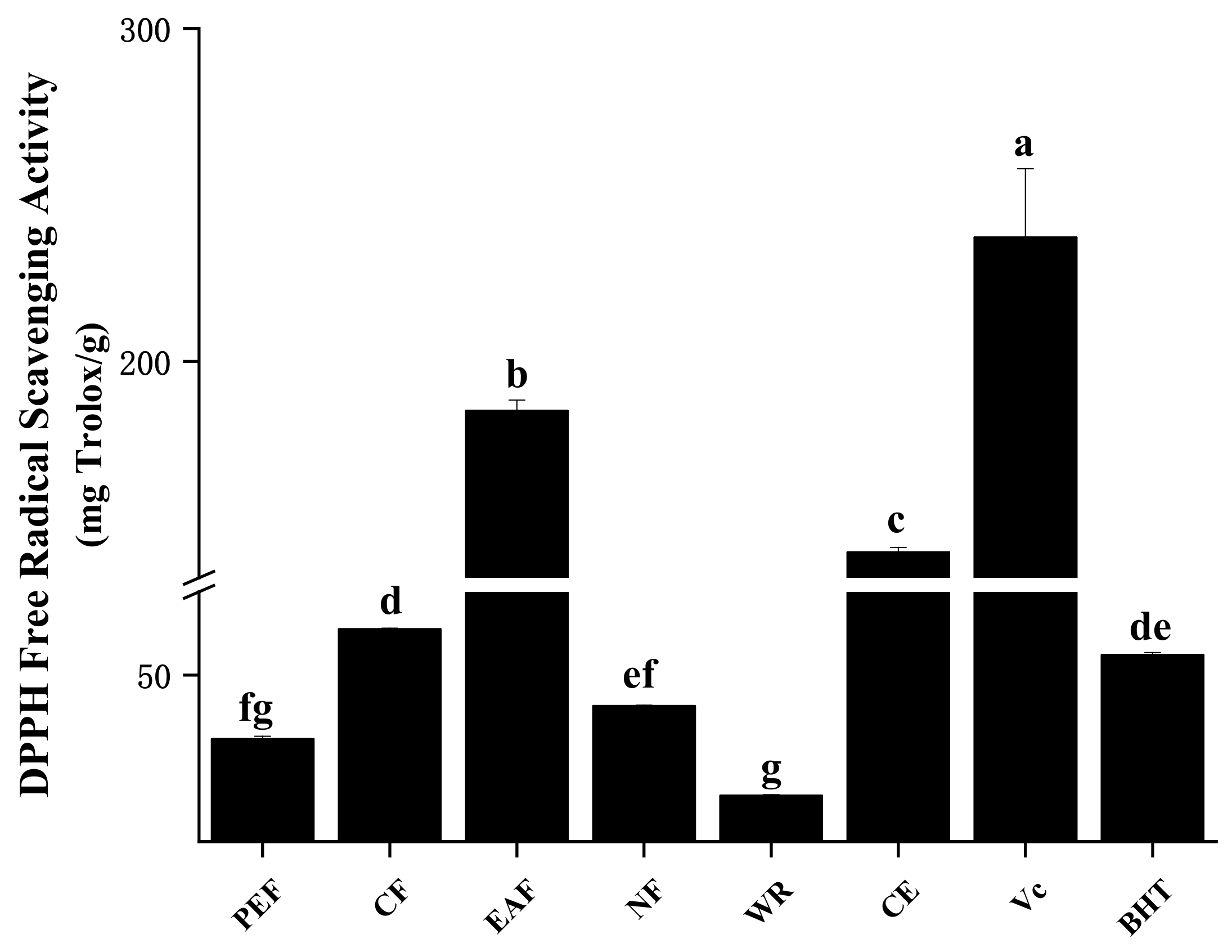


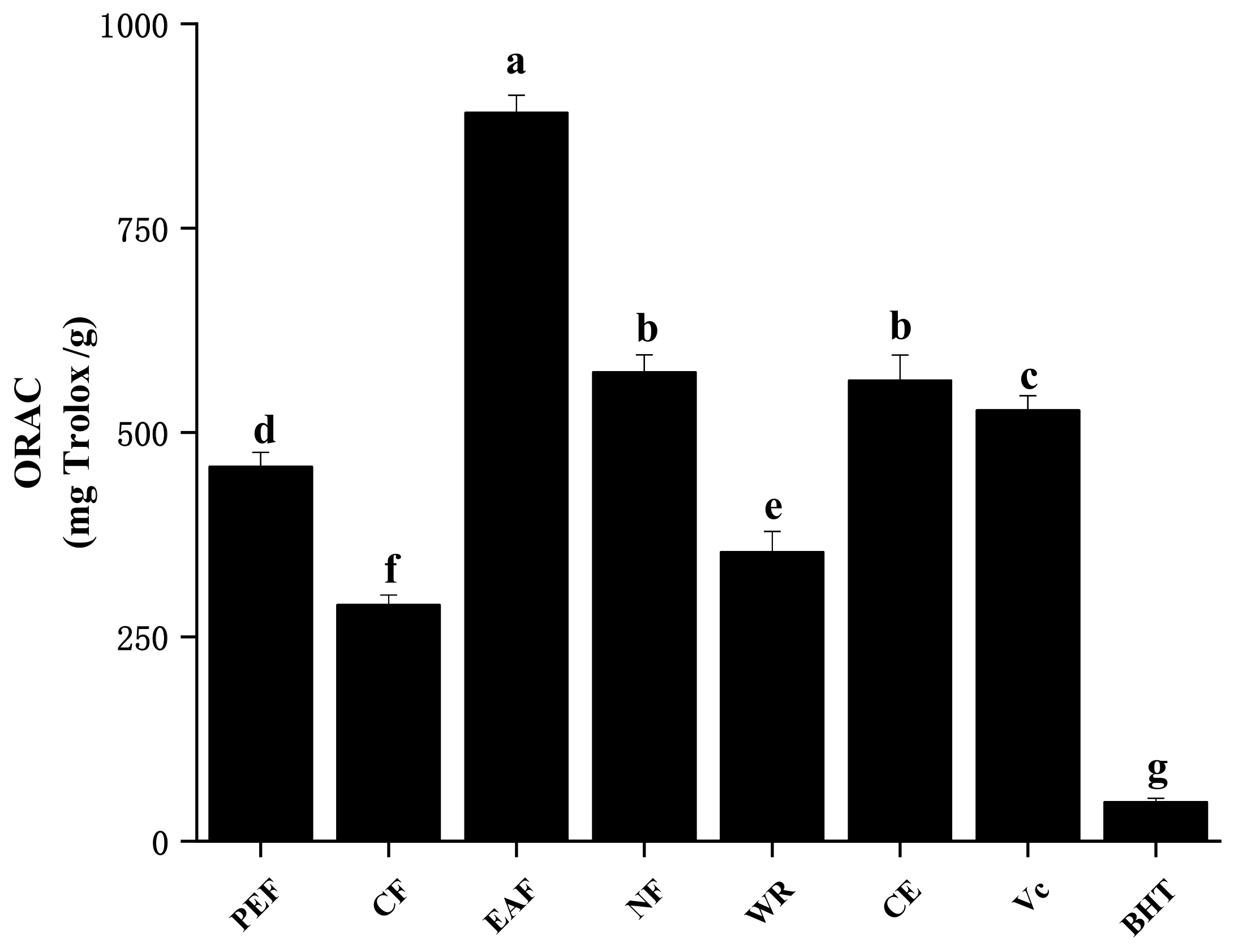

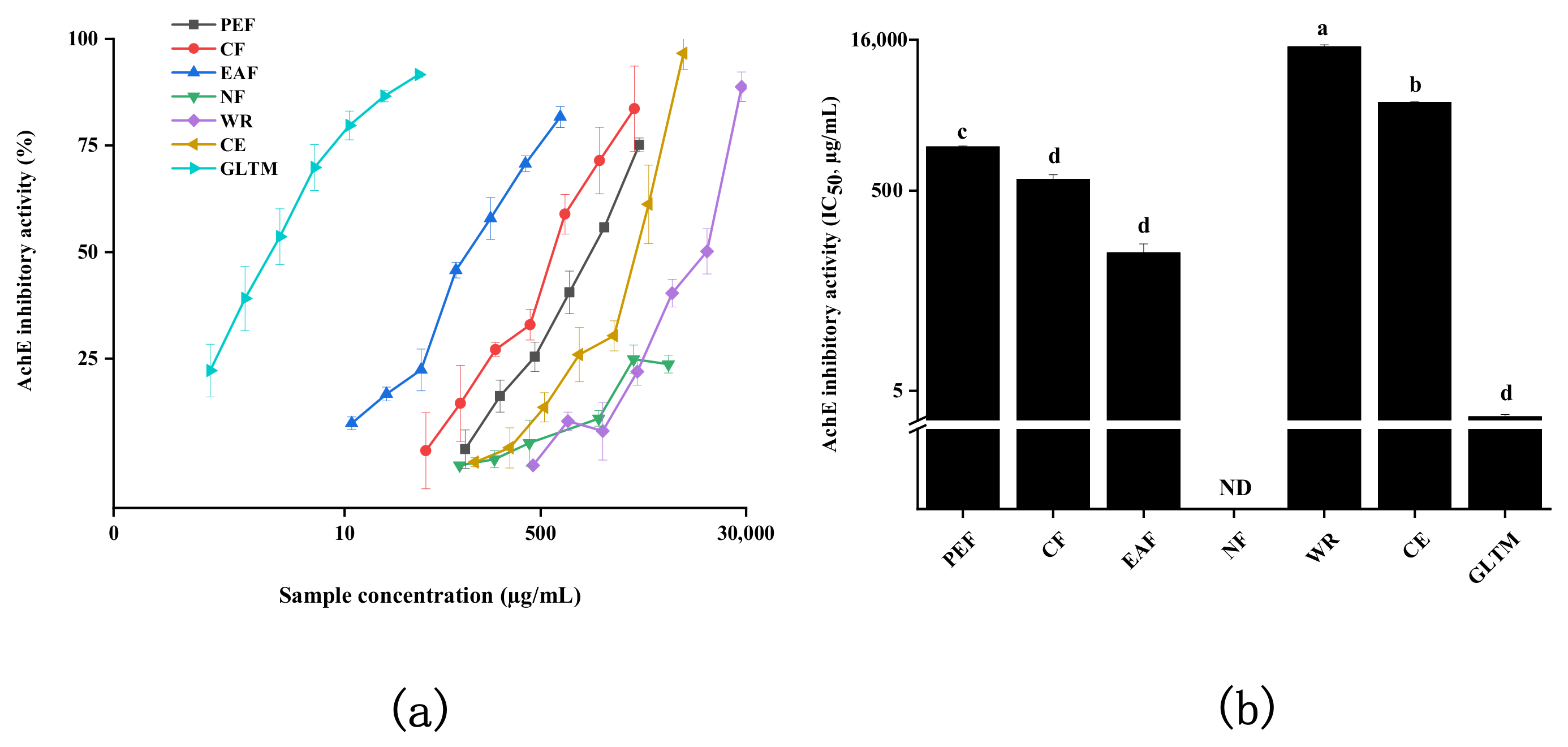
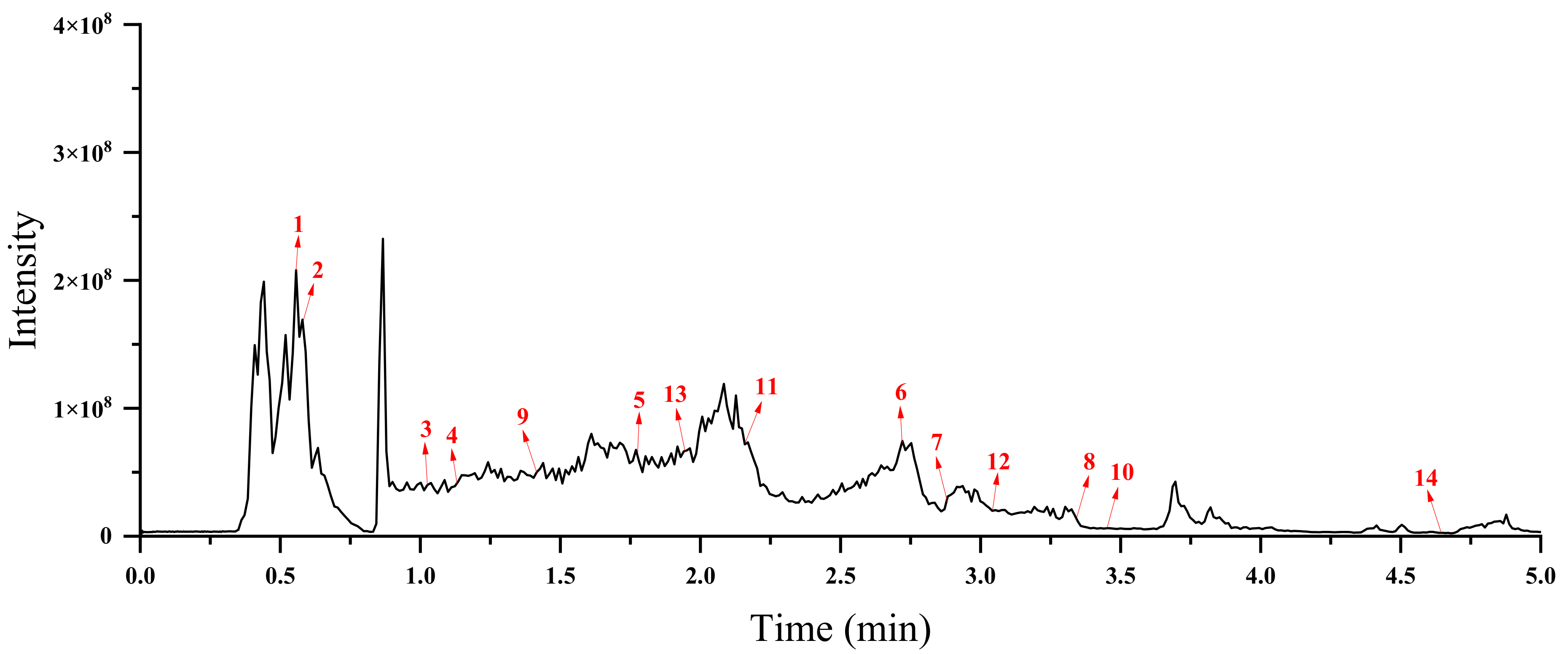
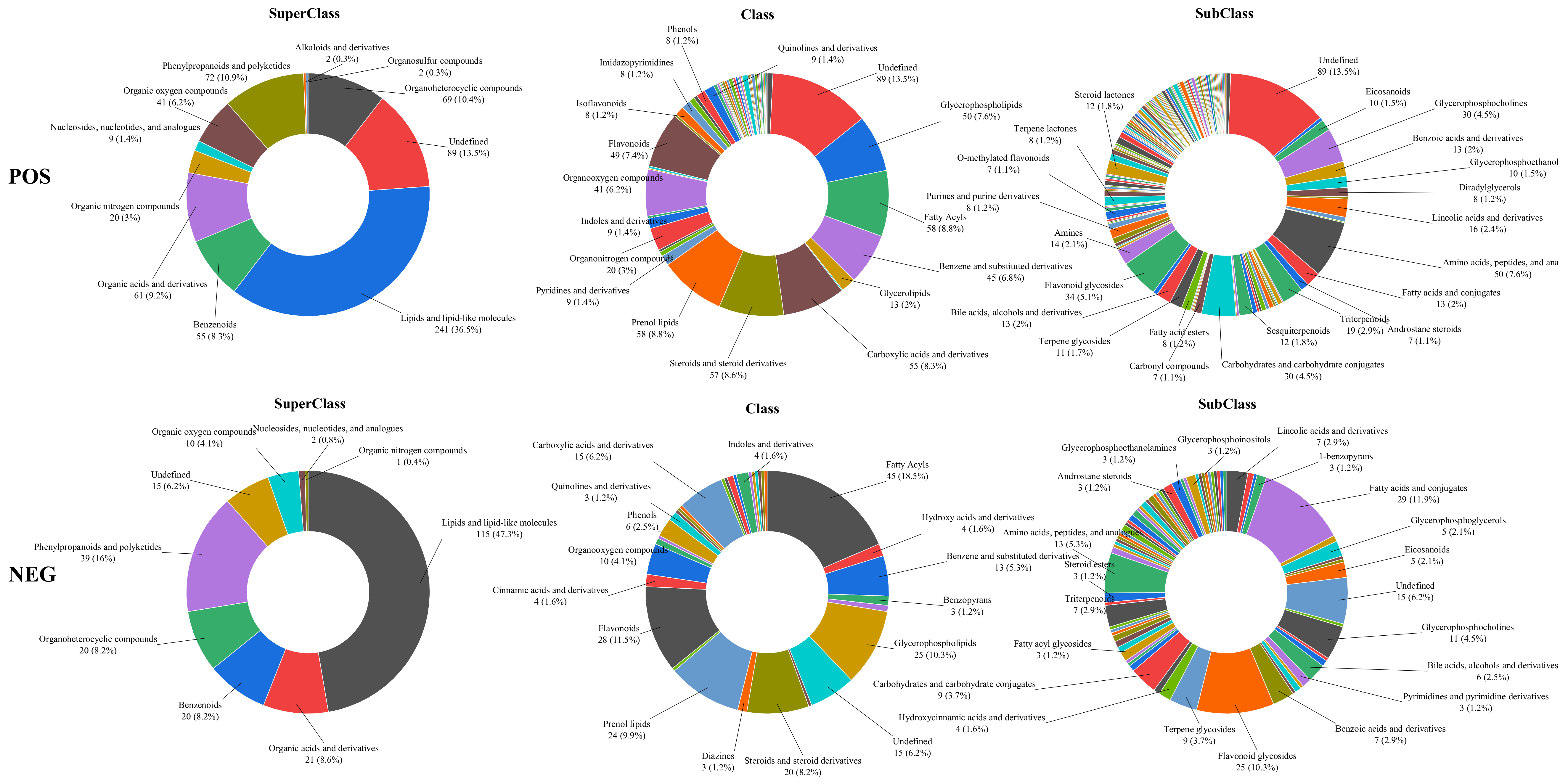

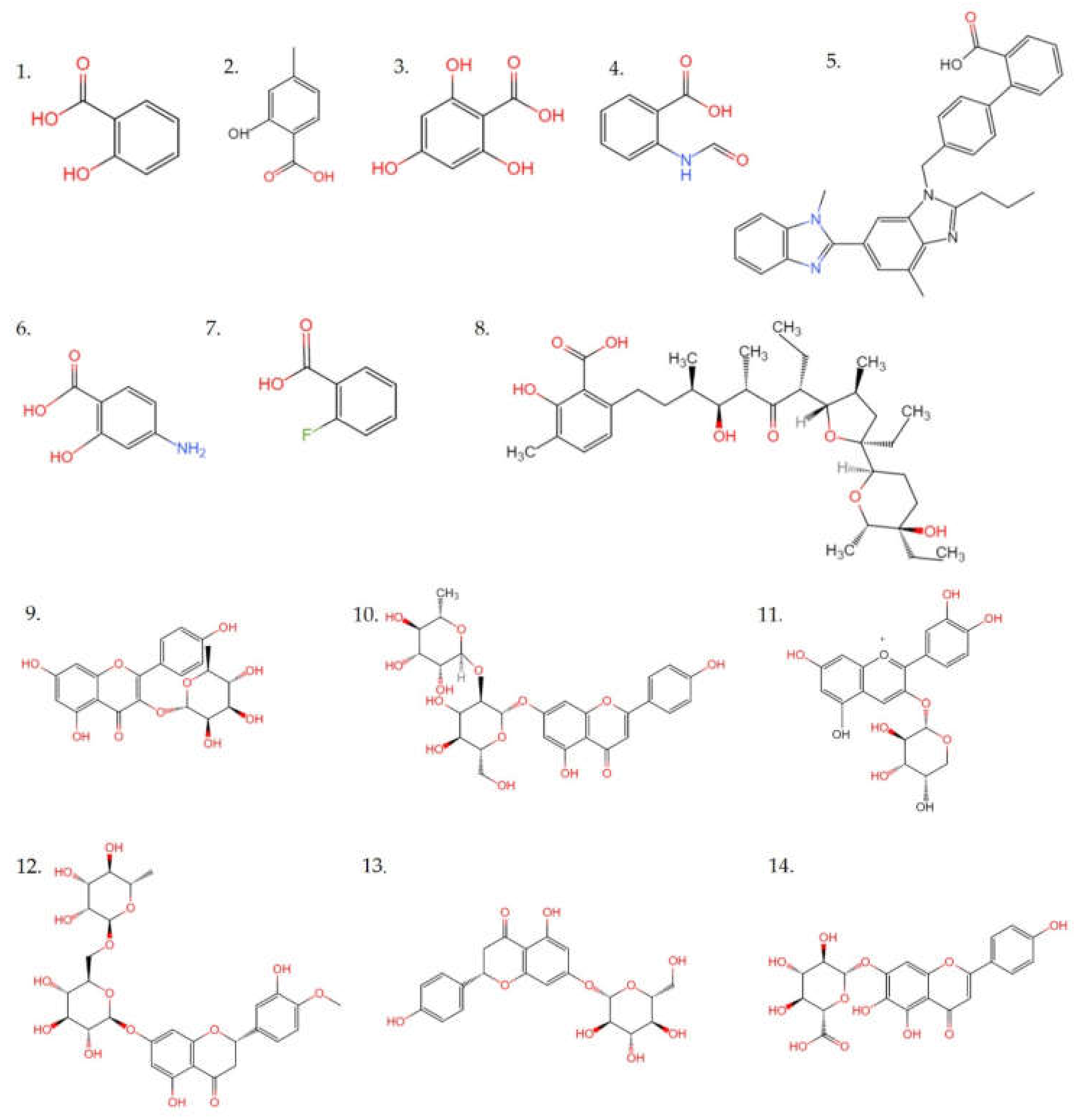
| Samples | TPC | TFC |
|---|---|---|
| PEF | 16.03 ± 2.49 a | 14.31 ± 2.17 a |
| CF | 86.74 ± 6.55 b | 68.94 ± 4.86 b |
| EAF | 345.57 ± 6.80 e | 279.36 ± 6.47 e |
| NF | 102.78 ± 8.33 c | 88.19 ± 7.43 c |
| WR | 27.10 ± 2.20 a | 18.02 ± 1.83 a |
| CE | 223.66 ± 11.35 d | 147.26 ± 8.00 d |
| TPC | TFC | DPPH | ABTS | FRAP | ORAC | α-Glucosidase | AChE | |
|---|---|---|---|---|---|---|---|---|
| TPC | 1 | |||||||
| TFC | 0.987 ** | 1 | ||||||
| DPPH | 0.971 ** | 0.952 ** | 1 | - | - | - | - | - |
| ABTS | 0.848 ** | 0.895 ** | 0.820 ** | 1 | - | - | - | - |
| FRAP | 0.963 ** | 0.981 ** | 0.923 ** | 0.929 ** | 1 | - | - | - |
| ORAC | 0.855 ** | 0.883 ** | 0.793 ** | 0.778 ** | 0.917 ** | 1 | - | - |
| α-glucosidase | −0.814 ** | −0.773 ** | −0.860 ** | −0.672 ** | −0.687 * | −0.467 | 1 | - |
| AChE | −0.439 | −0.466 | −0.526 | −0.547 * | −0.419 | −0.398 | 0.572 * | 1 |
| No. | Name of Compounds | RT(S) | Molecular Formula | Molecular Weight | MS/MS | Type |
|---|---|---|---|---|---|---|
| 1 | Salicylic acid | 33.017 | C7H6O3 | 138.12 | 93.0124, 75.0041 | Phenolic acids |
| 2 | 2-hydroxy-4-methylbenzoic acid | 34.092 | C8H7O3 | 151.14 | 107.0253, 92.0283 | Phenolic acids |
| 3 | Phloroglucinolcar-boxylic acid | 61.510 | C7H6O5 | 170.12 | 134.0500, 107.0377 | Phenolic acids |
| 4 | Formylanthranilic acid | 67.420 | C8H7NO3 | 165.15 | 92.0499, 120.0445 | Phenolic acids |
| 5 | Telmisartan | 107.033 | C33H30N4O2 | 514.63 | 276.2981 | Phenolic acids |
| 6 | 4-Aminosalicylic acid | 163.254 | C7H7NO3 | 153.13 | 108.0235 | Phenolic acids |
| 7 | 2-Fluorobenzoic acid | 172.283 | C7H5FO2 | 140.10 | 93.0368 | Phenolic acids |
| 8 | Lasalocid | 200.558 | C34H53NaO8 | 612.77 | 131.0722 | Phenolic acids |
| 9 | Afzelin | 84.989 | C21H20O10 | 431.0944 | 285.0321 | Flavonoids |
| 10 | Apigenin-7-O-neohesperidoside | 207.151 | C28H32O14 | 577.1501 | 269.0421 | Flavonoids |
| 11 | Cyanidin-3-O-alpha-arabinoside | 129.516 | C20H18O10 | 417.0802 | 287.0112 | Flavonoids |
| 12 | Hesperidin | 181.863 | C28H34O15 | 609.1797 | 301.0224 | Flavonoids |
| 13 | Naringenin-7-O-glucoside | 117.097 | C33H42O19 | 433.1118 | 151.0023 | Flavonoids |
| 14 | Scutellarin | 278.186 | C21H18O12 | 461.0705 | 285.0404 | Flavonoids |
| Elution Time (min) | Mobile Phase B Concentration (%) |
|---|---|
| 0–0.5 | 95 |
| 0.5–7 | linearly from 95 to 65 |
| 7–8 | linearly from 65 to 40 |
| 8–9 | maintained at 40 |
| 9–9.1 | linearly from 40 to 95 |
| 9.1–12 | maintained at 95 |
Publisher’s Note: MDPI stays neutral with regard to jurisdictional claims in published maps and institutional affiliations. |
© 2022 by the authors. Licensee MDPI, Basel, Switzerland. This article is an open access article distributed under the terms and conditions of the Creative Commons Attribution (CC BY) license (https://creativecommons.org/licenses/by/4.0/).
Share and Cite
Chen, X.; He, X.; Sun, J.; Wang, Z. Phytochemical Composition, Antioxidant Activity, α-Glucosidase and Acetylcholinesterase Inhibitory Activity of Quinoa Extract and Its Fractions. Molecules 2022, 27, 2420. https://doi.org/10.3390/molecules27082420
Chen X, He X, Sun J, Wang Z. Phytochemical Composition, Antioxidant Activity, α-Glucosidase and Acetylcholinesterase Inhibitory Activity of Quinoa Extract and Its Fractions. Molecules. 2022; 27(8):2420. https://doi.org/10.3390/molecules27082420
Chicago/Turabian StyleChen, Xi, Xuemei He, Jian Sun, and Zhenxing Wang. 2022. "Phytochemical Composition, Antioxidant Activity, α-Glucosidase and Acetylcholinesterase Inhibitory Activity of Quinoa Extract and Its Fractions" Molecules 27, no. 8: 2420. https://doi.org/10.3390/molecules27082420








